Oftentimes, you hear the term "tried and true" thrown around when discussing various game mechanics and styles of play. There may not be any flavor of strategy gaming more tried and true than that which was epitomized by the classic Panzer General released in 1994. Many, many war and strategy games have drawn from its simple, yet effective style of turn based combat. Just about every type of setting from fantasy, sci-fi and real history has gotten the Panzer General treatment at some point. If you aren't familiar with this sort of game, here's the quick version. Hexes, IGO-UGO turns, resource points, units which gain experience and are carried forward from mission to mission, and the ability to upgrade those units over time to bigger and meaner versions of themselves.

One of the most prominent of these successors was Panzer Corps from Slitherine, which stuck closely to the original setting of WW2, while updating everything about the game from the visuals to the number crunching going on under the hood. The game was obviously quite successful, as it spawned an almost never ending supply of official new campaigns and user made scenarios. Now Panzer Corps takes another leap forward in the form of a brand new sequel.
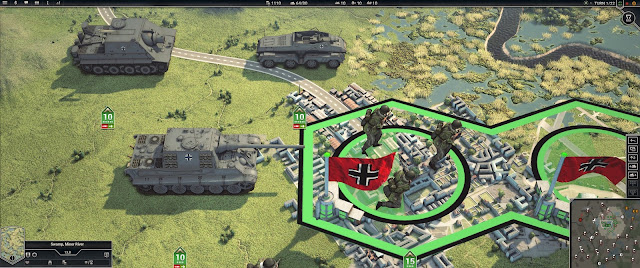
Right off the bat, Panzer Corps 2 is visually the prettiest thing Slitherine has ever released. Caught somewhere between trying to appeal to the wargaming crowd and the mass market, the publisher has put out many games over the years that were "just okay" when it came to visuals. With Panzer Corps 2 I think they can confidently say that they finally have a truly great looking game to show off. Not just on the technical side of things, but in terms of pure style. Panzer Corps 2 has got style in spades, even compared to many mainstream games. The entire package, from the menus, the unit models, the UI, the new strategic view, and most especially the map itself, looks sleek and polished. The colors really pop off the screen, with a perfect level of contrast and lighting that makes pretty much everywhere you fight look beautiful, be it green forests or arid deserts. The unit models all look great, being realistic enough, but with just a touch of style to smooth the edges, matching the look of the trees and mountains around them. The developers clearly were proud of the models, as you can zoom in as close as you like to check them out. I could go on, but you get the idea, this is a visually appealing game whether we are talking mainstream or wargames.
Now, how about the gameplay, are we looking at a massive leap forward there as well? Well, the short version is that if you loved the previous game, this is a no brainer to purchase. If you hated the first one, you probably won't find a radically different experience here. If you were in the middle, read on, as there are a lot of nice tweaks across the board that improve the experience in many ways.

Often, when a sequel to a game with a lot of DLC comes out, users find themselves feeling like the sequel is quite anemic in terms of content compared to the fleshed out previous game. They might also be concerned about the expectation of buying a lot of the same DLC all over again. (*cough* The Sims *cough*). With Panzer Corps 2, while I have no doubt DLC is on the way, the initial experience is quite beefy. The campaign only lets you play from the German side of the war, but features more than twice as many possible missions as the Panzer Corps 1 campaign. You can play the war from start to finish, or jump ahead to the operations of Barbarossa, Kursk, North Africa, or Italy. While playing the full campaign, you will often get chances to choose one branching path or another, offering different experiences on a second play through. In addition to a bigger campaign, Panzer Corps 2 also comes with a tutorial campaign, several tactical puzzles, some large standalone scenarios (Crete, Fall Weiss, a couple fictional ones) and a random skirmish generator. I found the random skirmish generator to be a fun alternative to the campaign, giving you a chance to experiment with all sorts of units and tactics while not worrying so much about being efficient across multiple missions. It also lets you set up chaotic free for all battles between every faction in the game, something you certainly won't experience in the normal missions. Not to mention all of this can be done in multiplayer matches as well.
I feel like a key missed opportunity here was not including some kind of mode akin to the Advance Wars series, where you fight over resource producing towns and unit producing factories. As far as I can tell, you get a starting set of units, initial resource points to spend as you please, and that's it. This makes for fierce but brief battles, which is fun but there's room for more here. I would have loved a mode where you start with perhaps only a couple basic units, and then gain resources each turn depending on which objectives you hold, leading to an escalation over time of more expensive units appearing on the battlefield. Just a thought, if developers or modders are listening!
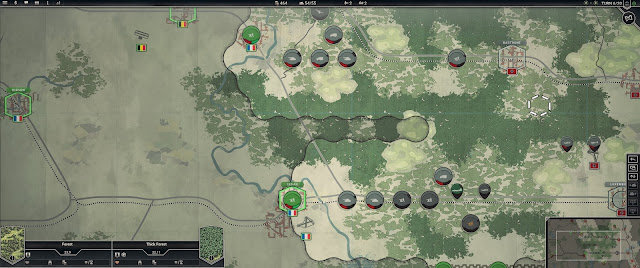
The mechanics of the game have been tweaked in a lot of minor and significant ways, although the core experience will be readily familiar to fans of the genre. Generally speaking, Panzer Corps 2 does a lot of things that give the player control over their experience and I love this aspect. When starting a campaign, you can choose a preset difficulty setting, or fine tune things in some interesting ways. For example, as in many turn based games, there is an undo button for those times when you misclick or just flat out make a bad move. Here, you have a ton of options about how this feature works. You can limit yourself to only so many "undos" per turn, or per mission, or none at all, or unlimited. You can change how revealing the map works, how random the combat results are, whether supply and weather are a concern, and how many commander trait points you get (more on that in a moment). You can also crank the difficulty way up in different ways, or switch on Ironman mode.
The game also gives you new options in how to shape your force to match your play style. At the beginning of the campaign, you can customize yourself as the commander. You get a couple of points to put into perks like extra mobility for tanks, or making enemy units deteriorate faster when you cut them off from supply. You can also choose some negative options like getting new units later, or not having access to artillery at all. Selecting these negative traits gives you more points to spend on the positive ones. This system is great, as it can really let you change up how you play the game on different campaigns. There is also a new system for specializing your units over time. After every mission you will get a new "hero" which you assign to a unit, and each unit can have up to three of these guys. Heroes don't give flat stat bonuses, which are always boring, but instead gives the unit an interesting perk. Some examples are one that gives the unit a large experience bonus when it takes losses, and another that causes any enemy unit attacked to lose all of its movement points for the turn. This in turn makes for fun choices about how to best utilize them and eventually combine 2-3 perks in one unit.

So now we've hit on many of the supporting elements of the game, but what's new and improved about the core of Panzer Corps: the combat? While the heart of the gameplay remains the same, numerous of changes have been made which add some much needed nuance to your battles. I won't list out every single change, but to suffice to say many changes have been made to make the experience more enjoyable, flexible, and minus a few of the frustrating aspects from the previous game. I will go into some of the things that were highlights to me, and made the combat much more engaging than before. One huge change is to the way supply works. It is now very similar to Order of Battle, in that certain cities and other spots on the map serve as supply hubs, and your units must be able to trace a path to them to stay "in supply." If cut off from supply lines by the enemy, a unit will quickly become less effective and then completely helpless. This is a great change, and opens up a lot of tactical decision making about cutting off enemy units instead of fighting head on, and deciding how risky you want to be when racing units ahead of your main force.
Direct combat has been changed with a more detailed system for suppression and accuracy. Units will now often take suppression "damage" which reduces their attack capabilities for the turn. Some units like artillery and anti-aircraft batteries will not do much direct damage, but will inflict a lot of suppression, indirectly protecting friendly units and softening up targets for attack. Accuracy is a new stat for units, determining how many of their shots actually hit in each attack. This value can be influenced by many factors, including the presence of an adjacent recon vehicle or aircraft. This makes recon units that much more useful in combat. There are actually many such adjacency bonuses that will influence how you shape and deploy your force. Having combat engineers on hand will let other units ignore some of the enemy entrenchment level, anti-tank units can now provide supporting fire from behind the front line, and having friendly units in flanking positions makes an enemy easier to attack.
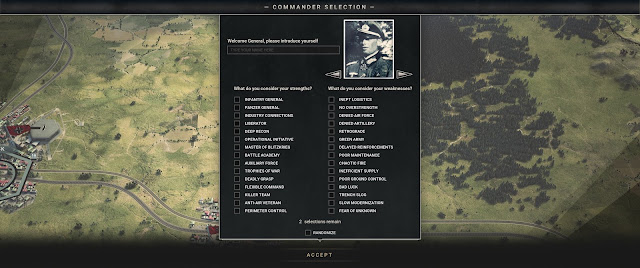
Another welcome change is how aircraft work. No longer do aircraft wander the battlefield for numerous turns, waiting to run out of fuel. Instead, they now can only operate within a certain range of their assigned airfield, and will return to base at the end of each turn. This feels much better than the old system, and gives each side a certain area of the map in which they can or can't project air power. Capturing airfields is more critical than ever, as doing so will allow you to bring your aircraft forward to continue supporting your advance.
There are many other changes I won't go into detail about, but all of them add up to make the experience of playing Panzer Corps 2 feel more polished and fun than ever before. The more nuanced combat model, the inclusion of unique perks for your commander and heroes in individual units, and the gorgeous, slick visuals combine together to make for a fresh beginning for a long standing series. A lot of these changes will go a long way towards addressing the chief complaint that many had about the first game, which is that it felt more like a puzzle you needed to solve than a true strategy game. Although I haven't made it all the way through the full campaign, I have yet to hit a point where I felt like continuing was impossible due to choosing the wrong unit mix along the way, or that a given scenario had one "correct" way of playing it. The many small changes have made it such that things are far more flexible, both on and off the field of battle.

Overall, I find Panzer Corps 2 to be a significant step forward from the previous game. Lessons have been learned both from that game and the success of other games in the genre over the past decade. Take those positive changes in design philosophy, along with some new ideas, and a fresh coat of paint, and you've got yourself a real winner. I think most anyone who enjoys this kind of game at all will enjoy Panzer Corps 2, and even some critics of the first title will be won over by the improvements.
- Joe Beard
Follow me Twitter at @_AWNT_ or email me at beardjoe33@gmail.com



















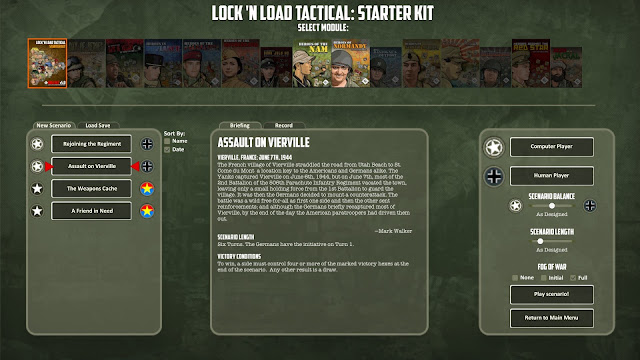


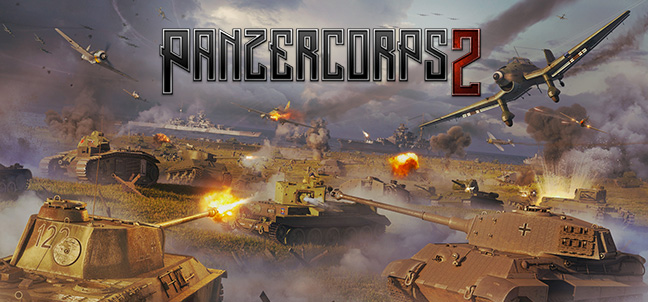





















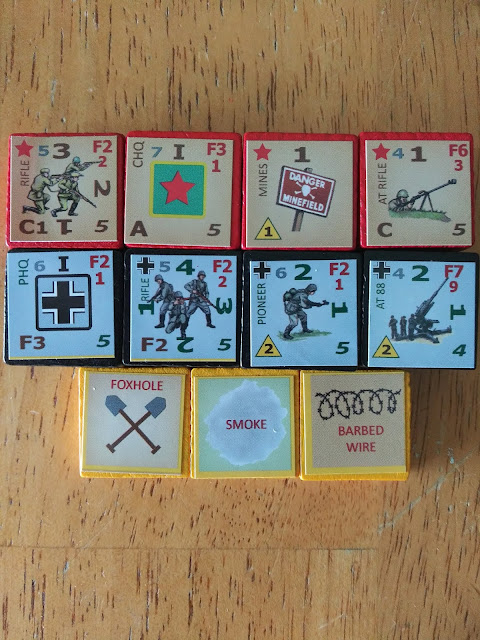



Follow Us